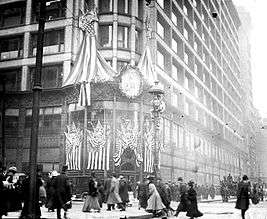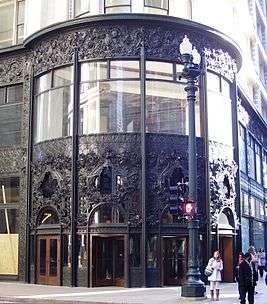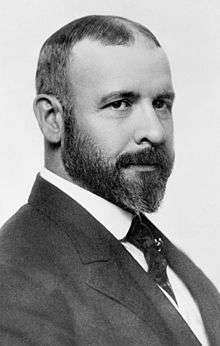Carson, Pirie, Scott and Company Building
|
Carson, Pirie, Scott and Company Store | |
|
Carson, Pirie, Scott and Company Building with 1904 and 1906 additions | |
|
| |
| Location | Chicago, Illinois |
|---|---|
| Coordinates | 41°52′54.16″N 87°37′39.18″W / 41.8817111°N 87.6275500°WCoordinates: 41°52′54.16″N 87°37′39.18″W / 41.8817111°N 87.6275500°W |
| Built | 1899 |
| Architect | Louis Sullivan; Burnham, Daniel H., & Co. |
| Architectural style | Late 19th and Early 20th Century American Movements |
| NRHP Reference # | 70000231 [1] |
| Significant dates | |
| Added to NRHP | April 17, 1970 |
| Designated CP | May 15, 1975[2] |
| Designated CL | November 5, 1970[3] |
The Sullivan Center, formerly known as the Carson, Pirie, Scott and Company Building or Carson, Pirie, Scott and Company Store,[4] is a commercial building at 1 South State Street at the corner of East Madison Street in Chicago, Illinois. It was designed by Louis Sullivan for the retail firm Schlesinger & Mayer in 1899, and expanded by him and subsequently sold to H.G. Selfridge & Co. in 1904. That firm occupied the structure for only a matter of weeks before it sold the building (the land under it was owned at the time by Marshall Field) to Otto Young, who then leased it to Carson Pirie Scott for $7,000 per month.[5] Subsequent additions were completed by Daniel Burnham in 1906 and Holabird & Root in 1961.[6]
The building has been used for retail purposes since 1899, and has been a Chicago Landmark since 1975. It is part of the Loop Retail Historic District.
Architecture

The Sullivan Center was initially developed because of the Chicago Great Fire of 1871. In 1872, the partnership of Leopold Schlesinger and David Mayer began after their immigration from Bavaria. In 1881 Schlesinger and Mayer had moved their dry-goods store into the Bowen Building that was on the corner of State and Madison. In 1890, Schlesinger and Mayer hired Adler and Sullivan to prepare plans for the removal of the Bowen Building’s attic story and the addition of two stories across the Bowen Building and the adjacent four-story structure to the south. The facades were added to match the bottom stories of the building and the building was painted white.
In 1892, Schlesinger and Mayer hired Adler and Sullivan to do further remodeling and add a new entrance to the corner of State and Madison. In 1896, Sullivan, no longer working with Adler, was asked back by Schlesinger and Mayer to redesign the façade and add two stories to the newly leased four-story building on Wabash avenue, as well as connecting it to the State Street store. That never happened because Schlesinger and Mayer changed their minds to make it a ten-story building, which also never happened. It eventually got painted white and then a bridge was added that connected the second story of the building to the elevated railroad. In 1898, Schlesinger and Mayer decided to remove the original building located on State and Madison replace it with a new building designed by Sullivan. Sullivan had both a nine and twelve-story proposal made up for this new building. They eventually started with a nine-story portion of the building that was made on the Madison Street side next to the original portion of the Adler and Sullivan renovations.
In 1902 Schlesinger and Mayer came back to Sullivan wanting a twenty-story building on State and Madison, eventually settling for the final twelve stories. The Madison Street portion that was added earlier did not structurally support twelve stories so it was left as is. Sullivan came up with a three-stage plan to finish the new building and allow Schlesinger and Mayer to keep their business running during the Christmas season.[7]
The building is remarkable for its steel-framed structure, which allowed a dramatic increase in window area created by bay-wide windows, which in turn allowed for the greatest amount of daylight into the building interiors. This provided larger displays of merchandise to outside pedestrian traffic creating the idea of the sidewalk showcase. In between the windows were lavish bands of terra cotta that replaced the earlier plan for white Georgia quarries because it was lightweight and inexpensive. Another reason for the change in what type of marble they would use in construction was that stonecutters were having a strike in 1898 during the time of construction.[8] The lavish Bronze-plated cast-iron ornamental work above the rounded tower was also meant to be functional because it was to be as resilient as a sheet of copper. Both the use of bronze and terra cotta was important to setting the building apart from others because it was essentially fire resistant. It created a sense of monumentality. Sullivan thought the building would be an asset to the city for a long period of time. To ensure this great building would last and be resilient against the threat of fire, there was a 40 ft water tower put on the roof to supply the sprinkler system with enough water.

Sullivan designed the corner entry to be seen from both State and Madison, and that the ornamentation, situated above the entrance, would be literally attractive, which would give the store an elegant unique persona important to the competitiveness of the neighboring stores.[9] The building is one of the classic structures of the Chicago school. The way this technique was used on the lower floors of the building were so elaborate that it used the natural lighting and shadows to seem almost as if it were magically floating above the ground.[10] The top floor of the 1899 and 1904 sections of the building were recessed to create a narrow loggia topped by an intricately detailed cornice that projected beyond the facade of the building. This was removed around 1948 and the 12th floor redesigned to replicate the lower floors.[11]
In the early years of development there was an addition that grew to be very valuable in spotting the building from afar. This addition was the pedestrian bridge that connected the train station, behind the store on Wabash Avenue, to the second floor of the Sullivan Center. This too was coated in elaborate metalwork and provided a sense of special entry to those who used it.[12]
In February 2006, the first phase of a multi-year restoration of the building's upper facade was completed. In addition to cleaning, the cornice and supporting columns were recreated on the 12th floor.[11] A 2001 report put the budget at $68.9 million for this renovation.
In August 2006 the parent company of Carson Pirie Scott, (Bon-Ton Stores Inc.), announced that after the 2006 Christmas season, the department store in the building would close. There were no immediate announcements as to what would occupy the building after the store's closure. After holding clearance sales, Carson's closed in February 2007.[13]
The 943,944-square-foot (87,695.3 m2) three-building complex, now renamed the Sullivan Center, is currently owned by Madison Capital, a private real estate company based in New York, New York.[14]

In 2008, a second renovation project of the decorative iron work on the lower three floors began. This included the State Street facade as well as rear portions of the building which face Wabash Avenue. Part of the funding for this renovation was provided by the City of Chicago. The Wabash facade was completed in August 2009 and the work on State Street in late 2010.[15][16]
Tenants of the Sullivan Center include the School of the Art Institute of Chicago and Gensler. In December 2010, Freed and Associates announced it was in talks with retailer Target, who expressed an interest in occupying part of the structure.[17] On February 15, 2011, the retailer announced it would lease 125,000 sq ft (11,600 m2) spread over two floors of the building. The new store opened July 26, 2012 and was met with favorable reviews for its clean design while being sensitive to the historic character of the structure.[18]
See also
References
- ↑ National Park Service (2006-03-15). "National Register Information System". National Register of Historic Places. National Park Service.
- ↑ "Carson, Pirie, Scott and Company Building". National Historic Landmark summary listing. National Park Service. Archived from the original on 2008-03-05. Retrieved 2008-07-20.
- ↑ "Carson, Pirie, Scott and Company Building". Chicago Landmarks. Archived from the original on 2008-06-13.
- ↑ Baeb, Eddie (11 February 2008). "New space boosts Loop retail vacancy rate". Crain's Chicago Business. Crain Communications Inc.
- ↑ Staff (August 12, 1904). "Big Store Is Sold - Carson Pirie Scott & Co. Buy Business of Selfridge & Co. - Large Bonus is Paid". Chicago Daily Tribune. p. 1.
- ↑ "Carson Pirie Scott and Company Building". essential-architecture.com. Retrieved November 8, 2010.
- ↑ Joseph Siry (1988). Carson Pirie Scott: Louis Sullivan and the Chicago Department Store. Chicago: University of Chicago Press. pp. 3, 65. ISBN 0-226-76136-3.
- ↑ Siry, p.97
- ↑ Siry, pp.3,65,77–79,82,88,90–93,101
- ↑ Scully, Vincent Jr. (1959). "Louis Sullivan's Architectural Ornament: A Brief Note concerning Humanist Design in the Age of Force". Perspecta. 5: 73–80. JSTOR 1566883.
- 1 2 Kamin, Blair G. (February 19, 2006). "Carsons restoration would make Sullivan smile". Chicago Tribune. chicagotribune.com. p. Arts & Entertainment-1. Retrieved November 8, 2010.
- ↑ Siry, pp.77–79
- ↑ "Carson Pirie Scott on State Street closing". Chicago Tribune. chicagotribune.com. August 28, 2006. p. 9. Retrieved November 9, 2010.
- ↑ Ori, Ryan (April 27, 2016) "Landmark Sullivan Center selling for $267 million" Chicago Real Estate Daily
- ↑ Kamin, Blair G. (August 19, 2009). "Sullivan storefronts dazzle once more". Chicago Tribune. chicagotribune.com. p. Live!-1. Retrieved November 8, 2010.
- ↑ Kamin, Blair G. (January 24, 2010). "Loop landmark looking a lot like its original self". Chicago Tribune. chicagotribune.com. Retrieved November 9, 2010.
- ↑ David Roderland, Frand Spielman; et al. (December 10, 2010). "Target close to deal to move into old Carsons on State Street". Chicago Sun-Times. www.Suntimes.com. Retrieved 2011-01-28.
- ↑ Blair Kamin (26 July 2012). "Retailer right on Target". Chicago Tribune. chicagotribune.com. Retrieved 2012-08-21.
External links
| Wikimedia Commons has media related to Sullivan Center. |

